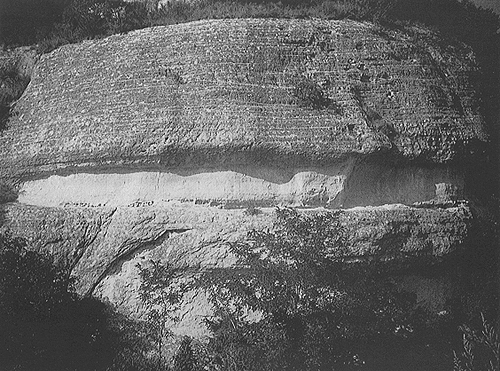
Stratification: hierarchy and cyclicity (1)
Plate 21

Stratification: hierarchy and cyclicity (1)
Plate 21
Facies similar to those shown in plate 20 alternate here again but on a different thickness scale. Sandstones are predominating over siltstones, and are organized in tabular bodies several meters thick. In the previous case, the alternating elements were individual beds; therefore, we have climbed a ladder in the hierarchical scale of rhythmic deposition.
Each sandstone body is composed of amalgamated beds. Wedging and undulations are visible in bed surfaces even at this distance. Bedding is not apparent, instead, in the lighter and more erodible siltstones.
Individual sandstone beds are vertically arranged in a roughly parallel way, but are lens and wedge-shaped. They have a limited lateral continuity, in contrast to the overall, tabular body. In other terms, the growth model is aggradational, as in the cases illustrated in plates 1, 2, 5, 6, but not of the layer cake type. This is because every single deposit affected a restricted area, and a lateral juxtaposition of beds was necessary to build up the whole body. The stratification can, in essence, be described in two ways: as a parallel, laterally discontinuous (wavy or wedge-shaped) bedding, or as low-angle cross-bedding. It depends on the definition of parallelism used (a broad or a restricted one). This geometry suggests deposition under the effect of strong storm waves, below sea level; the distance of observation prevents a closer examination of medium and small-scale structures, which would confirm this hypothesis. The structureless siltstones mark phases of rising sea level and weakened water agitation.
Pliocene Intra-apenninic sandstones, Val Marecchia area, northern Apennines.
Where vertical changes of lithology and bedding style (or, more synthetically, of facies) occur, one should observe how they occur: abruptly or gradually, with or without discontinuity. A gradual transition from a fine to a coarse clastic facies commonly indicates a shallowing trend or the advancing of a body that has a depositional base; these processes characterize a regressive phase of sedimentation. An equally gradual passage from a coarse to a fine facies reflects a deepening or transgressive trend. In the example illustrated here, both the base and top of the sandstone bodies are sharply defined; therefore, neither of them matches the just mentioned cases.
What is certain, in any case, is that changes in depth and sediment input did occur. Even if changes follow a cyclical pattern as in the case of transgressive-regressive cycles, the fact is that these cycles are not always (or rarely) recorded by continuous sedimentation. Discontinuities occur rather commonly and are expressed by sharp contacts, like those seen in the picture. There is a hierarchy of stratigraphic discontinuities as there is a hierarchy of sedimentation units (laminae, beds, layers, bodies, etc.). The relative importance and the various ranks of surfaces of discontinuity and unconformities are not discussed here, anyway, because they involve too many aspects of stratigraphy. Suffice it to point out the general meaning of discontinuities: when sedimentation stops and is replaced by erosion, a part of the stratigraphic record is canceled. If, for example, a shallowing trend culminates in the emergence of the sea bottom, the record of shallowing (a coarsening up sequence) can be entirely removed, and replaced by an erosional surface. Inasmuch as we sedimentologists are conscious that this can happen, we also know that the lacking sediments either were once present or never materialized. If we assume that they were deposited and then removed, we have a 50% probability of being right, and an equal probability of being wrong.[ol0]
I add another remark: transgressive-regressive oscillations, strictly speaking, are horizontal shifts of the shoreline, not necessarily caused by vertical movements of sea level. Local changes of depth can merely represent the passive record of these back and forth movements of the coastline. In a particular point of observation, the water depth increases (or a transition between emerged and submerged conditions occurs) when the sea is transgressing. The opposite happens when the sea is retreating from land. A local phenomenon of subsidence, for example, favors a transgression by depressing the surface below sea level in a coastal area such as an alluvial plain or a delta. The compaction of buried sediments, or the extraction of fluids from them, can be sufficient to cause subsidence in a limited area. In the rest of the world, however, the level of the sea remains stable: there are no regional or global sea level changes.